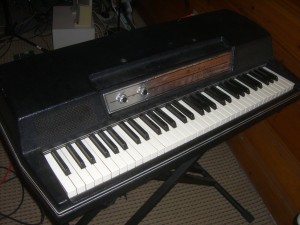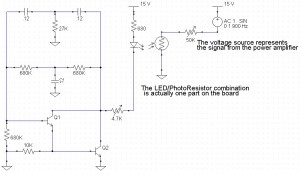Keep it simple, stupid
The KISS principle is pertinent in nearly every aspect of my life. I can’t begin to relay the number of times I have had to convince myself to step back from a situation–engineering or otherwise–and ask what the simplest solution is. Be it electronics at work or at home, renewable energy or even my investing, I encounter the KISS principle over and over again.
A tenet of the ever-expanding chip market is that the more functions that were once done with discrete components and can now be moved into the confines of a chip, the better. This is done either directly on silicon or by setting multiple pieces of silicon next to each other in the plastic packaging and wiring them together. This idea started a long time ago but is being to manifests itself in many different ways. One of the earliest examples is the op-amp. True, the form and function of the op-amp is different than the cascodes and the vacuum tubes that preceded it; but the idea of bringing the capacitor (to control the slew rate) and the transistors required to drive the differential inputs and the output all into the same package were just the first examples of combining discrete elements into an easily re-usable device was new. Another driving force was the idea that this device can be mass produced and sold at a lower cost thanks to economies of scale. More recently we have seen more and more functions brought into the chip packaging. One such example is the FPGA, which not only reduces the need for external logic gates in some bulky package, but it also makes it reconfigurable. And now, predictably enough, this same concept is being brought into play with analog! There are now chip manufacturers that make Field Programmable Analog Arrays (FPAA). Usually this consists of an op-amp, some analog switches and passive components, such as resistors and capacitors (for filtering). The device can be “programmed” to select any number of functions, with the potential for ever increasing complexity (though signal integrity would be a concern of mine). The final example is a product offering called the uModule from Linear Technology, with others doing similar things. It is an interesting concept because they are bringing in even more discrete components, such as inductors on a DC-DC converter; inductors are typically set outside the chip because of size concerns.
So how do these complicated chips affect designers and end users? They make things simpler (in theory). Open any modern day cell phone or look at a tear down, and you will see very little on the board in terms of discrete components (granted, this is also for space concerns). But chips that have everything included really do make everything simpler. Sometimes they are drop in solutions, such as with the uModule. All you need to do is determine the DC to DC conversion you want and then populate the board with their chip and two capacitors. On cell phones, there is usually 1 chip for each type of communication protocol (WiFi, CDMA, etc). If and when FPAAs ever become popular, they will only require that you populate a board with them, route the proper signals and then program what kind of filtering and amplification you want. This could even be as simple as saying what knee frequency you require and if you are particularly sensitive to ripple in the passband or stopband. Then the chip would know to use a butterworth, chebyshev, bessel, etc to get your desired results. The main point is, more and more people will be able to design systems, because the chip makers are paying attention to the minutiae (for a price, of course). This then allows fewer designers to make more designs, faster. Companies love the sound of that, because then they get more bang for their buck. As an aspiring futurist, I would even venture a guess that the system designers of tomorrow will really be software people with a knack for picking out parts. They will know what they need each part of the design to do and then will go through a catalog that will do it.
OK, so aside from using systems on a chip and not bothering to design systems when I can buy them, how else do I keep it simple? Well, a burgeoning hobby of mine is vintage analog electronics. Really I bought a 1968 Wurlitzer 200A electric piano on a whim and decided to fix it up/learn how to play it. The latter of those two goals is too lofty in the near term and shan’t be discussed here; however, the former of those goals has presented some good lessons from pulling this fine piece of equipment apart. When I first opened it and saw the components, I decided right away that I would be redesigning everything, including a new circuit board and using the most efficient new parts. However, as I’ve dug into the design I’ve found that not only would this be silly, it could be detrimental. One of the best things about vintage audio electronics is the intangible “warm” sound they often have. This could be from using vacuum tubes or just noisy components that were designed to create the best sound they could at the time. If I replaced everything, I would lose the natural sound of the instrument, basically rendering it useless (in terms of re-sale and in terms of playability). Instead, the simplest course of action is to replace the dried out capacitors with the closest match I can and leaving everything else alone. Simplicity wins again!
Renewable energy, specifically solar, has begun taking the KISS principle to a new level. Solar panels are not yet cheap or abundant as we want and need them to be. But mirrors are! So why not take a really simple method of essentially putting mirrors on a parabolic dish and then pointing it at a water tower? This simple approach then forces the steam through a turbine and voila, electricity. Now create a project that does this many times over, in a desert no less, and you have a serious contender for long term energy independence.
“The best way to own common stocks is through an index fund.”–Warren Buffett…The best investor in the world and one of my personal heroes, says this about 99% of investors. Regardless of what this says about his confidence in the average (and not so average) investor, I think it is a perfect example of keeping it simple. In fact, it doesn’t really get much simpler. And history has proven it too. In 2006, a study found that only .6% of active money managers can beat the market. Keeping it simple and buying that index mutual fund will ease your mind and your wallet!
Do I follow these ideas in my life and work? Sometimes. But as I experience more and more, I find that the KISS principle is one that could bring more harmony into many different aspects of my life.



